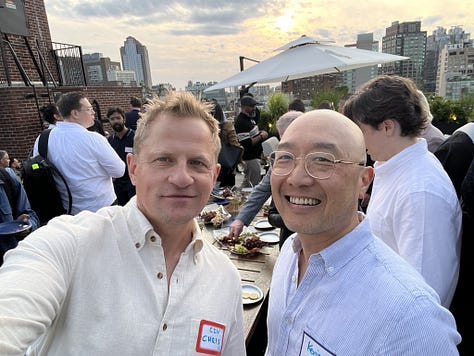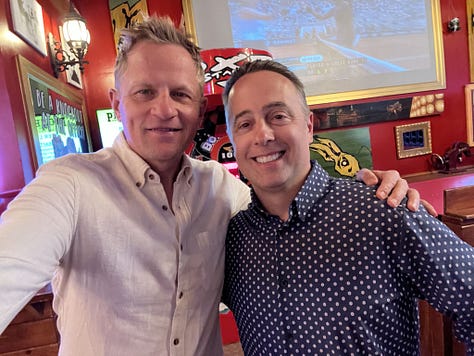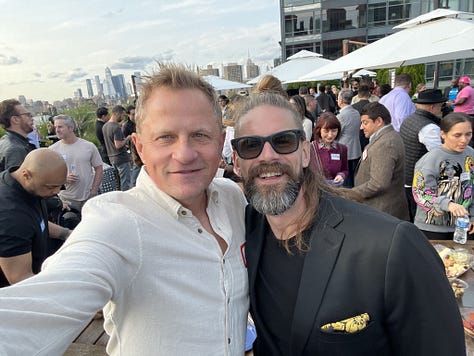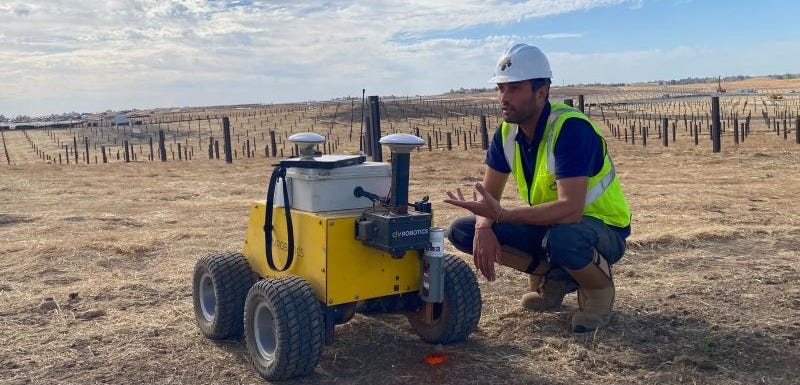C2V June Notes From The Trenches
Welcome friends!
As tempting as it was to sort through some of the increasingly surreal Big AI news ($100mm signing bonuses, billion-dollar-a-month burn rates, $1 trillion robotics/AI facilities, etc.), we felt compelled to finally scratch an early-stage venture itch that’s been bothering us for awhile with respect to expectations, conventions, and a related (and wholly unfair) stigma that needs to go.
One quick aside on the Big AI news, though – this line from an article on xAI’s new fundraising efforts made us chuckle:
“Backers include heavyweights like Andreessen Horowitz, Sequoia, and VY Capital—but even they have reportedly asked for more detailed financials.”
So… better $14-billion-late than never?
Okay, enough on that, we have more important fish to fry here. So, while we all try to recover from just how not-far-fetched Mountainhead was, let’s take a look at the state of Seed, Series A, and the vast gulf in the middle, notably, the increasingly common, generally prudent, and unfairly maligned “Seed Bridge” round.
We’ll get into the “why” of all this shortly, but first, the high-level.
The Delta Round
Post-Seed, Bridge rounds have long been considered by VCdom to be a rare and unseemly last resort, reserved for companies who mismanaged their budgets or had to undergo substantial pivots. While that may have been a mostly fair characterization in the past, today, we’re seeing the majority of perfectly healthy companies raising these Seed+ rounds simply because expectations for startups at Seed and Series A have widened so much that the gap has become extremely difficult to cross without a pit stop in the middle.
In other words, these Seed+/Pre-A rounds today are much more about topping off the gas tank to make sure companies don’t run out of fuel before they reach Series A than they are a recap of a pivoting company or a lifeline to a failing one.
Yet, despite the overwhelming body of evidence we’re seeing that confirms this to be the case (both in our own portfolios and in the broader market data), a heavy stigma remains attached to these Seed Bridge rounds within VC circles. We’ve been racking our brains for years trying to figure out why, and we think we have the answer.
This round needs its own name.
Does that sound kind of, well, dumb? You bet. But, notwithstanding that “dumb” isn’t necessarily an automatic disqualifier in this space, there are real reasons for VCs’ natural aversion to writing their first checks into something called a “bridge” round.
In large part, this is an inertia issue. Given enough time, stigmas take on a life of their own (going viral, as the kids say), and this creates a fear of being seen as the VC who fell into the bridge trap that everyone else was savvy enough to avoid.
On top of this, there’s also a strategy/branding issue. Look at how nearly all VCs describe their strategies. You will pretty much always see something like, “We invest in [list of generic adjectives that mean either “bold” or “innovative”] Pre-Seed and Seed companies”, “We’re a Seed & Series A fund”, “We look for [same generic adjectives] startups raising their Series A & B rounds”, etc..
This adds a related fear that if your first check into a couple companies are at “bridge” rounds and those are among the deals in your fund that eventually go south, they won’t just go into the bucket of expected zeroes, but will rather look like you went off script and blew it (and are therefore irresponsible/untrustworthy/etc). This is not without reason, either (i.e., LPs aren’t entirely innocent in all of this).
But give this baby its own name, and now it’s “We invest in [adjectives] Seed, [NewlyNamedRound], and Series A companies”, and we’re off and running. Sayonara Seed-Plus, Pre-A, Seed-Bridge, and all the rest.
So, what to call it? We propose:
The “Delta” Round
We like this one for a variety of reasons, including:
It stays within the 2-syllable limit of the current rounds
It’s easy to remember and a familiar word (i.e., no debate on pronunciation)
In the Greek alphabet, Delta follows Alpha, Beta & Gamma, the first two of which are already well-established stages of tech development, which generally coincide with (in our view, anyway) early and late Pre-Seed companies, respectively. Leaving an additional spot for the Seed round (i.e., skipping over “Gamma”) that brings us to Delta.
Lastly, Delta is both the mathematical term for the change in a variable and widely used in finance to mean the difference between two numerical terms, both of which nicely mirror where a healthy startup sits at this point in its lifecycle, relative to where it was at Seed.
Back to the “why”, with some supporting macro and C2V data.
Defending the Delta Round
Frequency
Per Carta’s most recent quarterly State of Private Markets, there are now nearly as many Seed Bridge rounds being raised as primary Seed rounds (46% to 54% in Q1). This is remarkable in itself, but we think it actually understates how frequent these rounds are, as Carta’s breakdown (as seen in the chart above) is among rounds that are being raised concurrently (i.e., the companies raising primaries are not the same ones raising bridges).
If you instead look at each quarter’s bridge rounds relative to primary rounds from prior quarters (using just about any Seed-to-Bridge time horizon), the number is closer to 55-60%. Add in the companies that failed without raising a bridge and those whose funding docs say “Series A” but are really a bridge, you’re likely pushing 65-70%, maybe higher.
Most notably, these percentages have increased dramatically over just the past four years (as indicated by the above chart).
Why This is Happening
As we alluded to above, it’s simply that the bar for traction/revenue run rates that most Series A VCs are looking for has moved incrementally higher over the years, while the general criteria for Seed is more or less the same.
That might lead one to think Seed standards should just move proportionally higher as well, but that would just create a similar gap between Seed and Pre-Seed. Plus, there’s already a round that’s proportionally (and achievably) closer to Series A — it’s called the Delta Round. See where we’re going with this?
The Unfair Stigma
While Carta’s broad market data can’t tell us anything about the quality of these companies raising Seed+ rounds, our portfolio can shed some light on this (albeit with a much smaller sample size). Of our companies at Series A or later (so, by definition, companies that are successfully executing), ~60% raised a post-Seed bridge round before their Series A.
Furthermore, we’re not seeing anything to suggest that companies that go directly from Seed to A will have better long-term outcomes than those that took a bridge pitstop along the way (and perhaps that the opposite is true?). Of our companies currently running at a $5 million or greater ARR run rate, those who raised a bridge round took an average of 40 months to go from Seed $5mm ARR, while those who skipped the bridge round took an average of 56 months.
Again, this is a relatively small sample size, and we’ll see how this evolves as our portfolios grow and current companies further mature, but it would certainly make sense if companies who raised more money between Seed and A were able to grow faster than those who ran leaner, trying to get to A without doing so. And if this is the case, that’s even more reason to drop the Seed+ stigma and just make it a regular funding stage.
Plus-Sized Seed Rounds
One last bit on this. It’s not news to the smarter VCs out there that the Seed to A leap has become considerably harder over the years, but we want to address the one “solution” to this challenge that you will most commonly hear – raise bigger Seed rounds. This one probably deserves its own newsletter, so we’ll do the short version here, but suffice it to say, we both fundamentally disagree with this premise and believe it to be a bit cynically self-serving.
In our experience, the average company that raises a $5mm Seed round will run out of money with exactly the same level of progress as the average company that raises a $2.5mm Seed. There are a bunch of more specific reasons why this is the case, but suffice it to say, founders who raise twice as much at Seed will do all the same experimenting and make all of the same mistakes; they’ll just spend twice as much on them (sometimes more). This is not a knock on these founders, at Seed, you just don’t know enough about how and where you should be spending money, and being looser with spending when you have more to spend is just basic human nature.
Furthermore, we don’t believe that the vast majority of VCs pushing outsized Seed rounds on companies are doing so because of the increased Seed-to-A challenges (though that does make for a convenient rationale), they’re doing so because they’ve raised funds that are too big for a Seed strategy and need to write bigger checks to make the math work.
Lastly, some data to support our postulate that Seed round sizes have rapidly diminishing returns over a certain size.
Looking at our portfolio companies, more than a year removed from our initial Seed round investment:
Those currently at $5 million or greater ARR raised a median Seed round of $2.6 million, and 80% raised less than $3.5 million
Those currently at $2 million or greater ARR raised a median Seed round of $2.5 million, and 69% raised less than $3.5 million
The Seed Bridge is dead, long live the Delta.
NYC Tech Week
Visiting long-time friends while running around NYC for tech week!



Kevin Ghim helped build appssavvy with Chris
Rob Deichert C2V LP
Rob Hughes Pitch Lift Founder
This month, Chris’s “Come walk with me” topics covered:

Gripp Raises $1.5M Pre-Seed to Expand Mobile-First Farm Operations Platform
Gripp, a mobile-first farm operations platform launched through Purdue University's DIAL Ventures, has secured $1.5 million in a pre‑seed funding round led by Ag Ventures Alliance and backed by Two Ravens, Infinity Holding Ventures, C2 Ventures, Tundra Angels, Countryside Angels, DMM Holdings, and Glen Haven Farms (prweb.com). Since rolling out in 2023, the QR-based system has been adopted by over 70 farms with zero customer churn and helps digitize daily tasks, equipment tracking, and operational knowledge. The funds will accelerate product development, sales, and marketing initiatives, and strategic partnerships to grow its market presence.
Breaking Boundaries: Expanding HTM into the Dental Field
At AAMI eXchange 2025 in New Orleans, UptimeHealth co-founder and CEO Jinesh Patel delivered a keynote titled “Expanding Horizons: How Biomedical Technicians Can Diversify and Capture New Markets.” He encouraged HTM professionals to leverage their existing skills to enter high-growth sectors such as dental, veterinary, and med-spa environments. Patel also announced a new partnership between AAMI and UptimeHealth to introduce the Dental Fix Summit at the 2026 eXchange. He emphasized the critical role of HTM experts in enhancing patient care and pioneering equipment-driven experiences, reminding attendees that “healthcare doesn’t exist without us.”
How Eskuad Map Forms Power Climate-Smart Forestry
Eskuad’s "Map Forms" brings climate-smart forestry to the forefront by enabling field teams to collect geolocated data via mobile forms—no paper, no manual entry. This empowers real-time tracking of tree planting, carbon sequestration, fire risk, and biodiversity metrics. By integrating GIS layers, customizable workflows, and device-level precision, forestry operations can monitor climate impacts, ensure compliance, and adapt practices more effectively. The result is streamlined workflows, improved data accuracy, and actionable insights, supporting sustainable, resilient forest management in the era of climate change.

Ash and Impilo Partner to Deliver Seamless At-Home Health Monitoring and Testing Nationwide
Ash and Impilo have joined forces to offer a seamless, end-to-end at-home health solution across the U.S. Ash brings a wide range of customizable at-home test kits (e.g., cancer, chronic condition, infectious disease, and HEDIS measures), while Impilo supplies technology-driven logistics and remote patient monitoring devices like BP cuffs, EKGs, glucometers, scales, and wearables. Their unified platform delivers kits and devices in a single shipment, enabling healthcare organizations to close care gaps and support proactive, data-driven care, with no in-person visits required. The service is now available nationwide to enterprise partners, digital health firms, payors, and health plans.
Rapid Waste Data Ingestion for Annual Reporting
A manufacturer struggled with scattered waste data, including over 20 waste streams, 100+ annual invoices, and 20 different vendors, which delayed annual reporting by more than a year and consumed significant manual effort. By implementing WATS’s specialized waste data platform, they quickly ingested and standardized a full year of data in just days, automated calculations, and converted disparate vendor reports into a unified format. This created a single source of truth, enabled real-time tracking, and transformed what had been months of reporting into a streamlined process taking mere days, freeing the team to focus on waste reduction and proactive management.
ASHRAE 2025
Excited to see leaders like Maret Thatcher spotlighting the future of connected construction at ASHRAE 2025. From BIM to digital twins to augmented reality, buildings are no longer static—they’re becoming dynamic, data-rich environments from the ground up. Looking forward to the conversation with Aaron Sorrell and Daniel Kolimar on how these technologies are reshaping how we design, build, and operate.
Founder Story
This is the kind of founder story that sticks with you. Rooted in real pain, real dirt, and real grit. What started as two recent graduates frustrated by outdated surveying tools has grown into Civ Robotics, with over 100 robots now deployed globally, transforming how infrastructure is built. Liav and Tomer didn’t chase trends—they solved a problem they lived firsthand. From dirt, for dirt… and just getting started.











